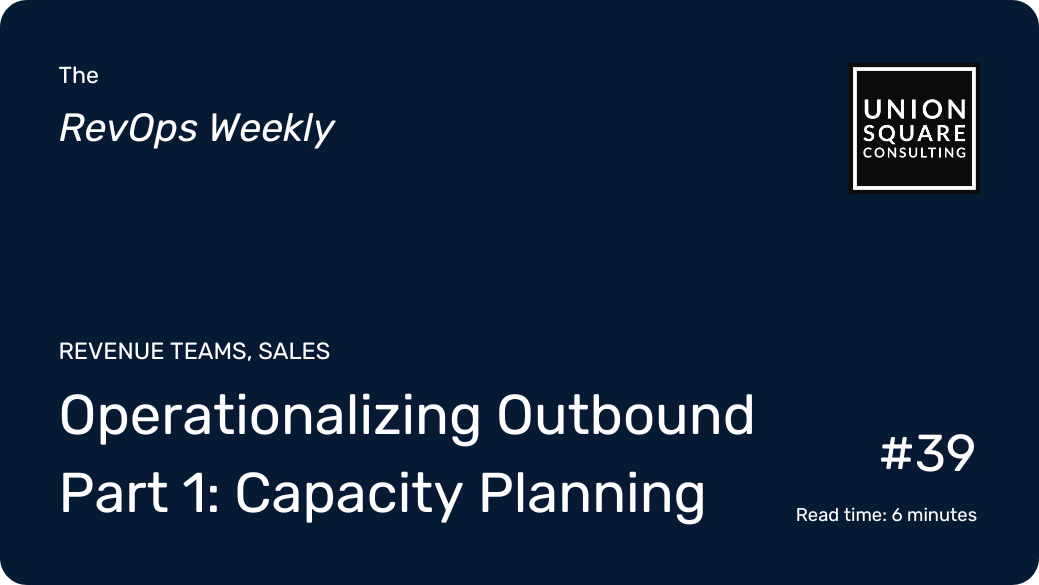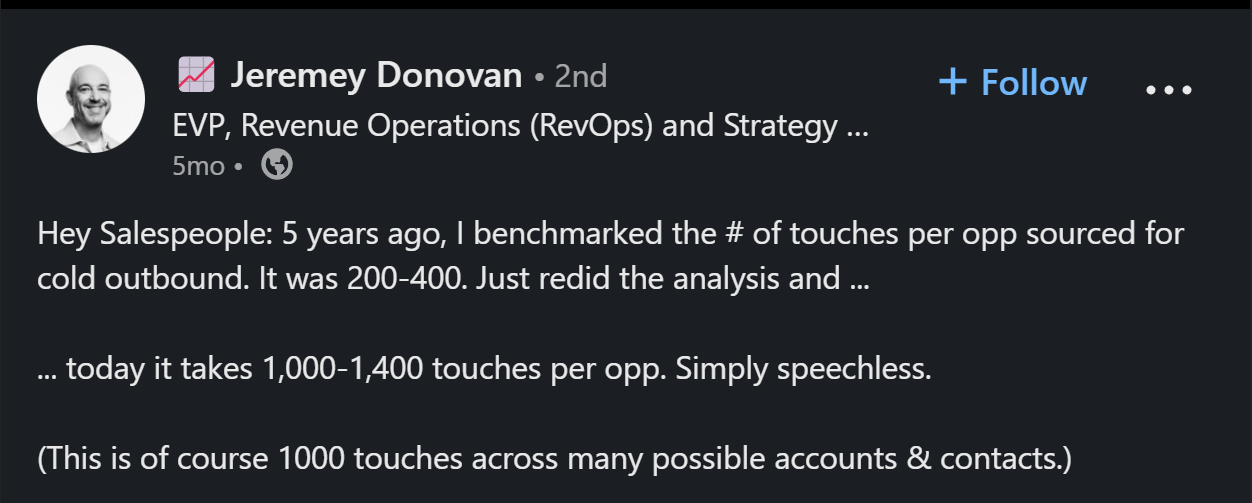
Operationalizing Outbound Part 1: Capacity Planning
Read time: 6 minutesExec Summary
- Outbound requires 3x more activities for a single opp vs. 5 years ago
- This statistic reflects poor process and is completely unsustainable
- Acquisition costs for “spray and pray” outbound are extremely high
- To grow revenue faster and decrease CAC, you need more focus
- This 3-part newsletter series will show you how to do it
- Part 1: Capacity Planning
- Part 2: Building the List
- Part 3: Creating Your Sequences
People like to say that outbound is dead, but it isn’t.
Pressing “Send All” is dead.
Jeremy Donovan from Insight Partners put this into context with a benchmark experiment five years in the making.
In a recent LinkedIn post, he said:
“5 years ago, I benchmarked the # of touches per opp sourced for cold outbound. It was 200-400. Just redid the analysis and …
… today it takes 1,000-1,400 touches per opp. Simply speechless.”
It’s incredibly expensive to pay SDRs and AEs to log 1,400 activities just to generate one opportunity. If you want them to create ten opportunities a month, that’s 14,000 activities.
Almost 1,000 activities per day. That’s insane.
The only way to do this is to hit “Send All”. Reps are now incentivized to automate away their sales process – and customers aren’t listening anymore.
Success rates for outbound have plummeted, creating a vicious cycle of needing more contacts, more activities, to land an opportunity.
So what’s the solution when you don’t have 500,000 contacts in your ICP and unlimited capital to fund extremely high acquisition costs?
You have to operationalize your outbound process, which means:
- Narrowing your focus
- Improving messaging quality
- Increasing your conversion rates
This newsletter series will walk you through every phase of creating an optimal outbound process, broken down into actionable steps.
There are three parts:
- Part 1: Capacity Planning
- Part 2: Building the List
- Part 3: Creating Your Sequences
Today we’re going to cover Outbound Capacity Planning.
Capacity Planning for Outbound
Stop asking “How many calls should an SDR make?”
Capacity planning for SDRs tends to be a bit overly simplified. Most people will ask questions like, “How many calls in a day should a rep make?”
The answer to that could be 20, or it could be 40 – if you get into Spray and Pray territory and have a big enough email list, it could be 1,000. (We’re strongly against this.)
Start asking “What does high-converting prospecting entail?”
The questions you have to ask are:
- What activities do you want your reps to do?
- What kind of research do you want them to do?
- How tailored do you want their messages to be?
- How long does it take to log a call with these steps?
- How many calls/emails/DMs can they send in an hour?
- How many hours each day do they have to prospect?
- How many contacts do we want to target per account?
- How many activities/contact is enough before giving up?
Capacity planning for outbound differs from the capacity planning we’ve discussed before in that our goal is to figure out how big our target list should be.
This way, we can focus on targeting only the best possible contacts.
Answering the above questions should tell us:
- How many activities a rep can log in a day
- With the hours that they have to prospect
- While taking the steps to maximize conversion
When I was an AE at Salesforce I had two hours per day to prospect, if I was lucky. In that time I could log 20 solid prospecting activities. If I did that, my pipeline was full.
Many top SDRs would log 40 activities, 80 if you count a call followed by an email, and +100 if we allow for some automated emails. Every team is going to have a different capacity depending on their unique circumstances.
Calculate the Right Number of Prospects to Target
Once we know how many calls a rep can make in a day without skipping steps, we can calculate the right size prospecting list for our outbound process.
For example, let’s say that:
- An SDR can make 40 quality calls per day
- With 20 work days per month that’s 800 calls
- We want 10 attempts in 30 days before giving up
- On average, after 8 attempts we’ll get a yes or no
- So that allows us to target 800 / 8 = 100 prospects
So if we have five SDRs and they can each manage 100 prospects a month, the target list needs to have 500 accounts per month (assuming you are only targeting one person per account, more on that below).
Consider how often you want to iterate.
You might spend time building these lists out once or twice a year, reshuffling them and making sure they’re current. Or, you might want to iterate faster and plan for a shorter time period, depending on how sure you are of your Ideal Customer Profile and Buyer Personas.
Identify the Personas in Each Account to Target
Make sure to map out the personas you want to target and adjust your account capacity accordingly.
For example, if you want to target VPs of Sales as well as CMOs, your annual list of 12,000 targets works out to be 6,000 accounts.
If you plan to target 12,000 accounts, you’ll actually be way over capacity.
When I worked at Salesforce there were usually 8-10 different roles we could sell to, so I spent an entire year working on less than 100 accounts. Many Enterprise AEs at Salesforce had only one account, but if you think about a company like General Electric, there are a LOT of people you could call.
This is why capacity planning is such a crucial first step in building an efficient outbound process.
We can run the same exercise for AEs. They have less time than SDRs to prospect but it’s a critical activity, especially in this market, nonetheless.
And Then What?
Now that we understand the true capacity of our SDRs and AEs, it’s time to figure out who goes on that list. In next week’s newsletter, we’re going to show you how to create a segmented outbound target list that will increase prospecting efficiency and reply rates.
If you haven’t signed up for the newsletter already, be sure to do so because you won’t want to miss next week’s issue! And for some free goodwill, consider forwarding this email to a friend or colleague who may benefit from a smoother outbound sales process.
When you’re ready, here’s how we can help:
Get a Free 1:1 Revenue Efficiency Workshop
Get one of our Senior Revenue Strategists to yourself for 1 hour and leave with a plan to increase the money-making power of your go-to-market operations.
Hire Us!
Bring us on as your Strategic RevOps Team and realize the growth potential of your revenue engine. There are 3 ways to work with us.
Get more tips like these, sent right to your inbox.
Subscribe for fresh, relevant revenue growth tips delivered every week.
